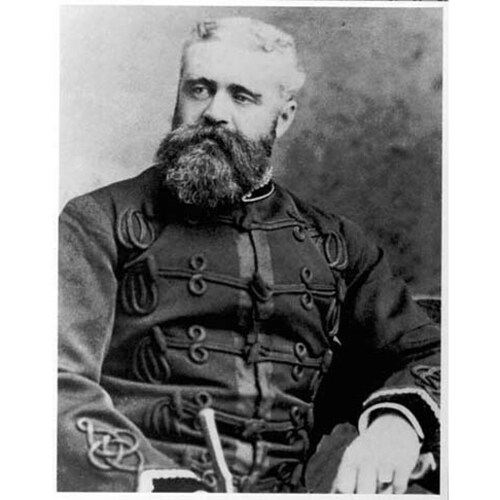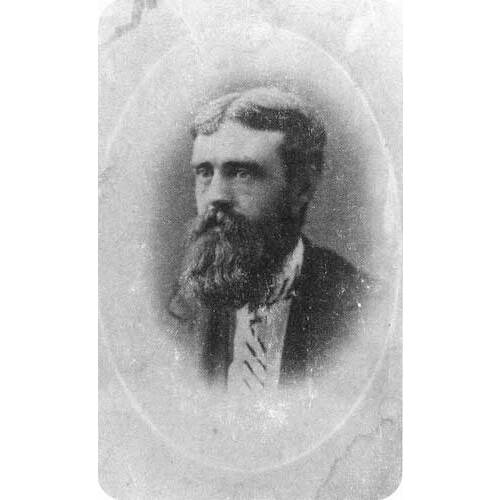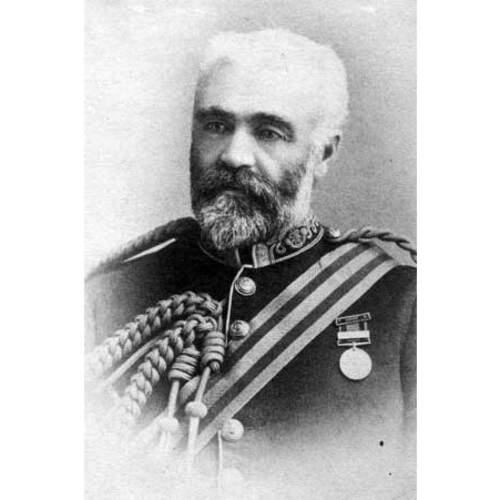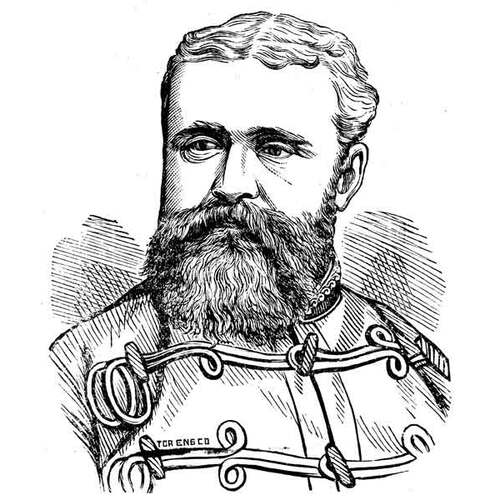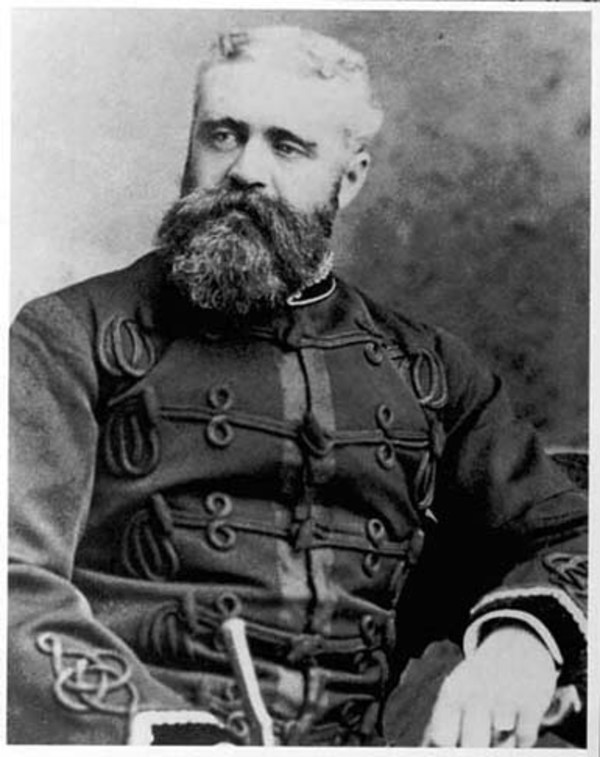
Source: Courtesy of Wikimedia Commons
BEDSON, SAMUEL LAWRENCE, soldier, office holder, and militia officer; b. probably 3 Feb. 1842 in Betley, England, son of Samuel A. Bedson, a soldier; m. first 25 Dec. 1872 Jemima Alexandrina Murray (d. 30 Dec. 1886), daughter of former HBC chief trader Alexander Hunter Murray*, in Winnipeg, and they had three sons and two daughters; m. secondly 15 July 1890 Florence A. McTavish in Chicago; d. 17 July 1891 in Ottawa, and was buried five days later in Winnipeg.
Born in a military camp where his father was a non-commissioned officer in the 16th Foot, Samuel Lawrence Bedson came to Lower Canada as a private with the same regiment in 1861. He stayed behind when the regiment returned to England in 1870. On 1 May he joined the 2nd (Quebec) Battalion of Rifles as quartermaster sergeant in the military expedition to the Red River settlement (Man.) under Colonel Garnet Joseph Wolseley*. When the battalion, which had been stationed at Lower Fort Garry, was disbanded on 1 May 1871, Bedson was chosen as warden of the provincial jail to be established in the stone buildings recently vacated by the soldiers. In 1874, after the common jail and provincial prison were moved to the new court-house at Winnipeg, Bedson became warden of the first federal penitentiary in Manitoba, at Lower Fort Garry. He continued in this position at the new federal penitentiary in Stony Mountain, which began receiving inmates on 2 Feb. 1877. Despite Bedson’s frequent protests, “lunatics” were housed in the Stony Mountain Penitentiary until 1885.
Having had no training in penal matters, Bedson applied strict military discipline, tempered with common sense and a warm humanity towards all. He insisted that his charges have proper food, clothing, quarters, and medical care, and that they be given meaningful work to do – erecting or repairing buildings, gardening, tending livestock, or shoemaking. He also started a school for illiterate prisoners. His work and the condition of the prison and its inmates were consistently praised in the yearly reports of the federal inspector. “The discipline is as near perfection as it could well be, and excites the admiration of every visitor,” noted an inspector in 1881. However, because the daily cost per prisoner was higher at Stony Mountain than at any other penitentiary, Bedson was cautioned from time to time about financial responsibility.
Bedson’s abilities in organization and discipline were recognized. In the fall of 1881 “discipline . . . had become impaired” at St Vincent de Paul Penitentiary near Montreal. The federal government appointed Bedson to restore order and “smooth the way for the Warden about to be appointed.” On 21 November, after five short weeks, he handed the administration, “in good order and condition,” over to the new warden, Godefroy Laviolette. An even greater challenge came in late March 1885, when Bedson was named chief transport officer by Major-General Frederick Dobson Middleton, commander of the military operations during the North-West rebellion. Although Bedson was officially a non-combatant, he was asked to perform front-line duties, including scouting. He was put in charge of the steamer Northcote which, despite constant sniping by the enemy, carried supplies to the troops at Fish Creek and Batoche (Sask.). His contribution to the success of the militia was highly praised by Middleton and others involved.
During the closing days of the campaign, Bedson and members of the headquarters staff, including Middleton, arranged to acquire furs that had been confiscated from Charles Bremner, a prisoner. When Bremner later complained, a select committee of the House of Commons investigated. Although Bedson never received his share of the furs – they were apparently stolen in transit – his name, and those of Middleton and the others, was somewhat tarnished when the committee decided that the furs had been taken illegally.
Bedson and his wife, Jemima, were renowned for the hospitality shown to all guests, from Governor General Lord Dufferin [Blackwood*] and Lady Dufferin, who toured the Stony Mountain Penitentiary in August 1877, to other official visitors, employees, and friends. At these times “Bedson was in his element for he liked people to come together for any kind of social event.” He was an avid sportsman, and for his friends and visitors he set up a six-hole golf-course, a curling rink, a race-track, and a hunting club, as well as a private zoo where he kept a famous buffalo herd. In 1888, when he disposed of the herd, it numbered 110 head, including both thoroughbred and cow-buffalo breeds.
Bedson retained his interest in military affairs, being active as lieutenant-colonel of the 91st Battalion of Infantry (Manitoba Light Infantry). In 1890 he was named extra aide-de-camp to Governor General Lord Stanley*. Late that October the Winnipeg Daily Free Press reported that Bedson was seriously ill and close to death. He eventually recovered sufficiently, from what was diagnosed as Bright’s disease, to return to his post as warden on 4 March 1891, but, weakened by his illness, he was forced to retire on 6 April. While on a trip to Ottawa, he was suddenly paralysed by a stroke and died on 17 July at the age of 49.
NA, RG 9, II, B4, 16: 4. PAM, MG 7, B15, reg. of marriages, 1862–1917, no.45. Stony Mountain Penitentiary (Stony Mountain, Man.), Letter-books, 1872–92; Order-books, 1875–84. Can., House of Commons, Journals, 1890, app.1; Parl., Sessional papers, 1876–93. Daily Free Press (Winnipeg), August 1877, March–July 1885, 1886–87, 1889–91. Pioneers of Man. (Morley et al.). Philip Goldring, The Manitoba Penitentiary and Asylum, 1871–1886 (Parks Can., National Hist. Parks and Sites Branch, Manuscript report, no.28, Ottawa, 1970). E. R. R. Mills, The story of Stony Mountain and district (Winnipeg, 1960). Philip Goldring, “Lower Fort Garry,” Beaver, outfit 301 (summer 1970): 34–36. J. D. Griffin and Cyril Greenland, “The asylum at Lower Fort Garry, 1874–1886,” Beaver, outfit 310 (spring 1980): 18–23. Steve Melnyk, “The fascinating history of the big house on the hill,” Winnipeg Tribune, 24 July 1965, suppl.: 1.
Revisions based on:
Find a Grave, “Memorial no.145570388”: www.findagrave.com (consulted 18 Dec. 2019). Vancouver Daily World, 21 July 1890.
Cite This Article
Lee Gibson, “BEDSON, SAMUEL LAWRENCE,” in Dictionary of Canadian Biography, vol. 12, University of Toronto/Université Laval, 2003–, accessed December 29, 2025, https://www.biographi.ca/en/bio/bedson_samuel_lawrence_12E.html.
The citation above shows the format for footnotes and endnotes according to the Chicago manual of style (16th edition). Information to be used in other citation formats:
| Permalink: | https://www.biographi.ca/en/bio/bedson_samuel_lawrence_12E.html |
| Author of Article: | Lee Gibson |
| Title of Article: | BEDSON, SAMUEL LAWRENCE |
| Publication Name: | Dictionary of Canadian Biography, vol. 12 |
| Publisher: | University of Toronto/Université Laval |
| Year of publication: | 1990 |
| Year of revision: | 2021 |
| Access Date: | December 29, 2025 |


